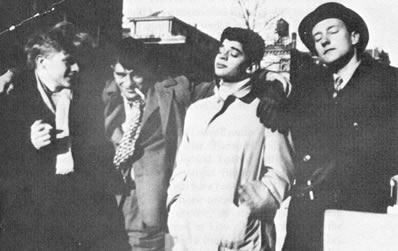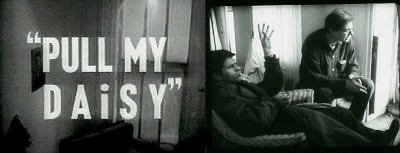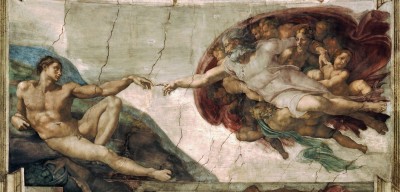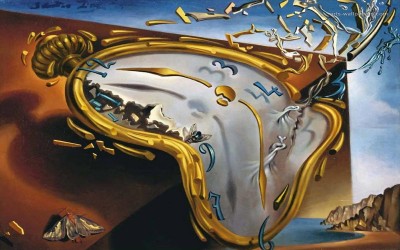Floating Universities —
The Power of The Collective in Art
.
Give me your befuddled masses,
Your rejection slips, pink slips, verbal slips, all;
Knock down the gates, throw open the bars,
The artists are havin a ball.
Teach me, show me, let me in;
Challenge me, push me, help me win.
Athletes have their team
And suits can wear the firm,
But making art keeps you home alone,
And the tavern’s the place you turn.
Solo suffering totally blows,
So into the sea you dive,
Searching for soles who swim like you
And act at least vaguely alive.
With deep sea wails you plunge the depths,
With freshwater poets you school,
With coral reefers you spark the sea,
Drinking in dreams from the pool.
.

.
Out of the one grow many, and out of many grows the One. The “It.” The Ahhh. The ah-ha! The Unspoken Thing. And from this desire for oneness, togetherness, the artists from the Beat poets to the Pranksters to the Lilith songwriters have collaborated, cajoled and consoled each other into movements and generations.
The Beat Generation may never have had a single unified voice any more than Generation X does, but their range of harmonies ended up blending into a pretty inspiring choir.
The term was coined by Jack Kerouac, expounded upon by John Clellon Holmes in the New York Times Sunday Magazine, and endlessly championed by Allen Ginsberg, partly because the prior “generation” of disaffected visionary American writers had come up with the convenient “Lost Generation,” thanks to Mama Stein. Hemingway — another pretty shrewd self-promoter — dropped her phrase as an epigraph to his first novel, The Sun Also Rises, and suddenly F. Scott Fitzgerald, Hart Crane, John Dos Passos, e.e. cummings and et al were no longer a bunch of struggling writers, but a generation. “Yeah, that’s it, we’re a generation!” We’re talkin’ ’bout my g-g-generation. Suddenly lone 1950s authors joined a team, and instead of remaining disparate spindly voices drowned out by a raging torrent of daily fads and fixations, each of their challenging visions became buoyed by the others.
And in this supportive spirit, a loosely defined Beat community became a very interdisciplinary affair as they freely mingled and collaborated with Abstract Expressionist painters, jazz musicians, Living Theater actors, playwrights, photographers, cartoonists, dancers, mystics and poets from other New York Schools. In smokin’ Greenwich Village joints like the Cedar Tavern, the San Remo and the Artists Club, something more than ideas were being exchanged.
“We were sharing the holy light,” said composer David Amram, Kerouac’s principal musical collaborator. “The Artist’s Club was a beautiful get-together run by artists for artists, with talking, philosophy, arguments and discussions by the hour by serious and brilliant people. Then afterwards we’d all go over to the Cedar Tavern and continue the rap. It was like a floating university.”
The Cedar Tavern, now woven vibrantly into the quilt of New York City history, was the collective comfort zone for Jackson Pollock, Willem de Kooning, Franz Kline, Larry Rivers, Frank O’Hara, various art critics, and the Beats as they emerged on the scene. Located originally on 8th Street & University Place, it was a tiny tavern with no jukebox or anything else, deep in the heart of the Village when it still was one.
“We had a lot of love and a gigantic extended family of friends,” Amram says of the Cedar scene. “You could sit at any table and hear the most inspiring conversations about art, theater, music, baseball, everyday living. It was an oasis, a mecca.
“There was a communal sense; we all helped each other rejoice in the struggle rather than despairing, by always encouraging and paying attention to each other, and trying to give that love and respect and interest, and also honest opinions and criticisms.”
.

Nowhere is this more visually animated than in the 1959 film Pull My Daisy, the single most illuminating Beat collaboration. Narrated by Kerouac’s best 28 minutes on tape, captured in early cinema verité by evocative still photographer Robert Frank, playfully scored by the classically trained David Amram who also appears as the friendly French hornist Mezz McGillicuddy, and starring Allen Ginsberg, Gregory Corso and Peter Orlovsky as themselves, this Lower East Side home movie is the only existing footage of the Beats in their prime other than a few scattered TV clips. Co-produced by painter Alfred Leslie and shot in his canvas-filled loft, featuring painter Larry Rivers in the role of Neal Cassady (who was sadly imprisoned in San Quentin at the time), with art dealer Richard Bellamy as the bishop antagonist, and financed by Wall Street libertine painter Walter Gutman, it’s a film made by painters about poets narrated by a novelist.
Another inspired collective on the path were the writers and artists of the Black Mountain College of North Carolina, an experimental Appalachian art school whose faculty included poets Charles Olson, Robert Creeley and Robert Duncan. Flourishing between 1950 and 1957 (when the school went bankrupt), their manifesto was Olson’s 1950 essay “Projected Verse” which emphasized the transferral of energy between a poem’s creator and reader. Their influential Black Mountain Review was one of the first regularly published collections of the wide-ranging free-verse voices of the new American poetry movement, with Creeley, William Carlos Williams and Denise Levertov appearing alongside Ginsberg, Kerouac and Gary Snyder. In 1952 the Black Mountaineers produced Theater Piece 1 — America’s first “happening” — which teamed Olson’s unfettered poetry with the work of artist Robert Rauschenberg, avant-garde musician John Cage and choreographer Merce Cunningham.
.

Also dancing in the klieg lights of collective freedom was the Living Theater, the iconoclastic company founded by Julian Beck and Judith Malina, who began their playful, interdisciplinary association in Greenwich Village in the late ’40s. In their first years of production (1951-1952), they staged plays by such diverse contemporary artists as Pablo Picasso, T.S. Eliot, Gertrude Stein, Kenneth Rexroth and John Ashbery. Rather than acting within the confines of conventional theater, they practiced street theater, confrontational theater, interactive theater, wholly living theater. As longtime member Steve Ben Israel described their method: “When you’re an actor, you’re waiting for a playwright to get an idea, or a director to do a play, or a producer to produce a play. And here we were, actors creating all of that — producing, directing, writing and acting it together with our specific message.”
.

This same blessing of community has been felt by artists ranging from the High Renaissance in Florence to the also fairly high Poetry Renaissance in San Francisco. Most of the resident groundbreaking geniuses of Florence circa 1500 belonged to some regimented guild or patron’s stable, so, many of the artists like Michelangelo, Leonardo, Filippo Lippi and Rustici, along with architects, storytellers and poets, would also gather in their own mock confraternities. In one of the more wacky images in art history, picture several of these blazing masters meeting as they did in their Company of the Cauldron, for lively drunken dinners around a giant cooking pot in one of their sculpture studios where they’d begin creating murals not with paint but with the chicken legs, sausages, cheese and jelly. Even though their quarrels were nearly as colorful as their art — never has a generation of artists advanced their media so quickly. “Hi! I’d like you to meet my friend, David.”
In San Francisco in the 1950s a community of poets began a similarly inspired coffeehouse collective, meeting and reading in the nooks and bookstores of North Beach. Embracing the Platonic adage, “To good men’s parties good men flock unasked,” the cultural outlaws from around the nation who’d gathered in this traditionally liberal port city were starting to notice the same faces on the same stages night after night. Poets like Gary Snyder, Michael McClure, Lawrence Ferlinghetti, Robert Duncan, Kenneths Patchen and Rexroth, assemblage artists like Bruce Conner and Wallace Berman, and filmmakers like Kenneth Anger and Harry Smith all began enthusiastic crossover interdisciplinary collaborations that were breaking society’s birdbrained habit of pigeonholing artists. A lush flower garden had burst into bloom and it wasn’t long before the psychedelic paisley ran wild.
.

In a sunshower of Day-Glo paint, Ken Kesey and his Merry Pranksters had a great notion to take the collective to an even higher level. Incubating in pools of acid on the edge of Stanford University, Kesey was forming an ever-expanding coterie of authors and intellectuals that would eventually encompass Neal Cassady, the Grateful Dead and electric KoolAid. As Intrepid Traveler Ken Babbs put it, “The Pranksters are a collective of that American spirit that’s been passed on from the founding fathers through Melville, transcendentalism, Whitman, Faulkner, the Beats and zoom into the Pranksters where it took a wild turn of spontaneity in tribal dance, uninhibited jazz, nonsensical word raps and any other unfettered reaching of the spirit toward newfound freedoms.”
A healthy dose of this Prankster ethic came from the pranksterish Dadaists who were trying to overthrow not only the rigidity of the fine arts in the 1910s and ’20s, but civilization itself. By staging pranks in public places like cathedrals in the middle of a service, this gang of offbeat artists and authors had a collective effect on history rather than simply getting arrested as solo psychos.

And out of their inspired playfulness grew the more serious subconscious exploration of the Surrealists. Founded by the psychologist and poet André Breton, and including Salvador Dali, Joan Miró and René Magritte, the Surrealists strove to fuse our dreamscapes with reality, creating “an absolute reality, a surreality.” Blending psychology, poetry and painting into a collage of the subconscious, the Surrealists were on a dedicated search for the meaning of life in the mysteries of the mind that Freud had only recently begun to unveil. Their direct channeling of the subconscious through trance-like states and automatic writing appealed to many artists of the time. Painter, occasional William Burroughs collaborator and regular cut-up Brion Gysin joined the Surrealists in Paris, as did future Beat poet Philip Lamantia in New York, who also helped edit their magazine View. But joining this group had a disturbing caveat: Namely, you could actually get expelled from it by Breton — as both Dali and Gysin were — for hanging with the wrong people or changing your mind, which is a curious condition for a mind-based movement.
But along the way, the group had a lot of fun poking a carrot in the eye of the snobby Parisian art world as they painted green apples on faces, and eyes in the middle of baked hams. Now picture Monty Python’s cartoons of a head popping out of a foot, or a naked man playing an organ in a field. The Surrealists expanded on the illogical juxtaposition of thought earlier espoused by the French poets Apollinaire and Lautréamont and the line of their legacy is still being doodled.
And that’s the great thing: As much as these cool collectives were happening in the recent past, many are thriving today. From communal artists’ hearths like New York’s Nuyorican Poets Cafe and The Knitting Factory to attention-getting rock fests like Lilith Fair and the Tibetan Freedom Concerts, groups of likeminded people are still working together for the collective better.
“It’s good for the soul, for one thing,” Sheryl Crow told me of joining the Lilith tour. “I mean, it’s what religion’s based on — that commune, the community, the solace and the fellowship of people who have a kindred spirit.”
Whether it’s painting the walls with dinner in Florence, or breakfast in bed for 400,000 at Woodstock, coming together stretches the horizon beyond the sun of its parts. And you don’t have to be half-a-million strong. As George Harrison put it of his much smaller group, “That was the good thing about being four together. Not like Elvis, you know. I always felt sorry for him later ’cause he was on his own. He had his guys with him, but there was only one Elvis and nobody else knew what he felt like. But for us, we all shared the experience.”
Being together counts. Even a collective of two. Supporting someone who is supporting you is the seed of a generation.
.
==================================
.

Here’s another essay from “The Rolling Stone Book of The Beats” — Abstract Expression: From Bird to Brando.
Here’s a cool exploration of Jack’s book Pic.
For more on the modern day Merry Pranksters collective — here’s where I met up with them at Woodstock.
Or here’s what doing New Year’s Eve with the Pranksters is like.
Or here’s what happens if you go down the rabbit hole with Pranksters in Wonderland.
Here’s some pretty killer reviews of my new “Hitchhiker’s Guide to Jack Kerouac“
And here’s a whole bunch more. 😉
Here’s a great radio interview where I go into a whole bunch of similar Power of The Collective ideas.
And here’s a joyous riffin’ print interview that explores the meaning of “Beat” and how it impacted culture at large and fits in the world today.
Here’s where you can get the book in the U.S. Or in Canada. Or in the U.K.
.
==============================================
by
Brian Hassett karmacoupon@gmail.com BrianHassett.com

5 responses so far ↓
1 Wizard of Wonder // Mar 6, 2016 at 9:38 AM
Amazing stuff, Brian. What a fun read!
2 Jeanne Masanz // Mar 6, 2016 at 11:01 AM
I’ve not read much of this book, but did read all of your pieces. It’s a treasure trove.
3 Al Robinson // Mar 6, 2016 at 6:53 PM
Amazing that you tracked it back to the Renaissance. I dug your deep digging. Keep going.
4 Sarah Welch // Mar 6, 2016 at 9:20 PM
This is one of the best ones yet. Thank you for this perfect Sunday read. Chris and I never stop learning really cool things from you.
love, Sarah and Chris
5 Nina Rosca // Mar 26, 2016 at 9:59 AM
Amazing stuff, Brain! I love your writing, so lively, so fresh! I would love it if you’d consider helping me out with a survey about Charles Bukowski and The Beat Generation. I will keep my questions brief. It won’t take much of your time; a response by email will suffice. I already dropped you an email. In case you miss it and want to know more about my research, email me at denisa.rosca@my.westminster.ac.uk Cheers!
Leave a Comment